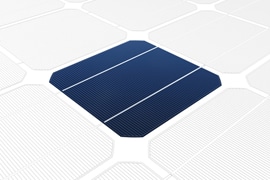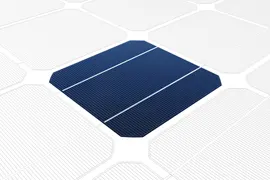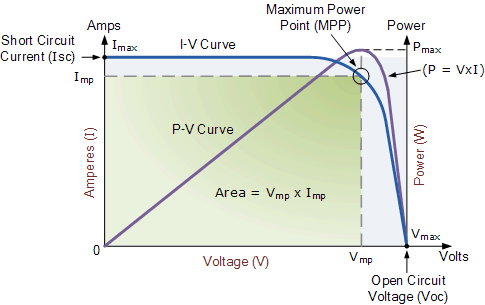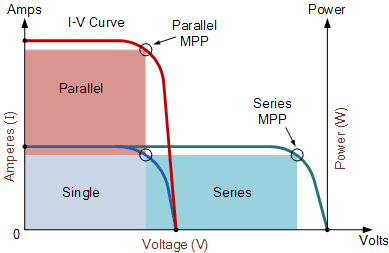
Solar Cell I-V Characteristic Curves
Solar Cell I-V Characteristic and the Solar Cell I-V Curve
![]() The Solar Cell I-V Characteristic Curves shows the current and voltage (I-V) characteristics of a particular photovoltaic ( PV ) cell, module or array. It gives a detailed description of its solar energy conversion ability and efficiency. Knowing the electrical I-V characteristics (more importantly Pmax) of a solar cell, or panel is critical in determining the device’s output performance and solar efficiency.
The Solar Cell I-V Characteristic Curves shows the current and voltage (I-V) characteristics of a particular photovoltaic ( PV ) cell, module or array. It gives a detailed description of its solar energy conversion ability and efficiency. Knowing the electrical I-V characteristics (more importantly Pmax) of a solar cell, or panel is critical in determining the device’s output performance and solar efficiency.
Photovoltaic solar cells convert the suns radiant light directly into electricity. With increasing demand for a clean energy source and the sun’s potential as a free energy source, has made solar energy conversion as part of a mixture of renewable energy sources increasingly important. As a result, the demand for efficient solar cells, which convert sunlight directly into electricity, is growing faster than ever before.

Photovoltaic ( PV ) cells are made made almost entirely from semiconductor silicon that has been processed into an extremely pure crystalline material which absorbs the photons from sunlight.
The photons hit the silicon atoms releasing electrons causing an electric current to flow when the photoconductive cell is connected to an external load. For example, a battery. There are a variety of different measurements we can make to determine the solar cell’s performance, such as its power output and its photovoltaic efficiency.
The main electrical characteristics of a PV cell or module are summarized in the relationship between the current and voltage produced on a typical solar cell I-V characteristics curve. The intensity of the solar radiation (insolation) that hits the cell controls the current ( I ), while the increases in the temperature of the solar cell reduces its voltage ( V ).
Solar cells produce direct current ( DC ) electricity and current times voltage equals power, so we can create solar cell I-V curves representing the current versus the voltage for a photovoltaic device.
Solar Cell I-V Characteristics Curves are basically a graphical representation of the operation of a solar cell or module summarising the relationship between the current and voltage at the existing conditions of irradiance and temperature. I-V curves provide the information required to configure a solar system so that it can operate as close to its optimal peak power point (MPP) as possible.
Solar Cell I-V Characteristic Curve

The above graph shows the current-voltage ( I-V ) characteristics of a typical silicon PV cell operating under normal conditions. The power delivered by a single solar cell or panel is the product of its output current and voltage ( I x V ). If the multiplication is done, point for point, for all voltages from short-circuit to open-circuit conditions, the power curve above is obtained for a given radiation level.
With the solar cell open-circuited, that is not connected to any load, the current will be at its minimum (zero) and the voltage across the cell is at its maximum, known as the solar cells open circuit voltage, or Voc. At the other extreme, when the solar cell is short circuited, that is the positive and negative leads connected together, the voltage across the cell is at its minimum (zero) but the current flowing out of the cell reaches its maximum, known as the solar cells short circuit current, or Isc.
Then the span of the solar cell I-V characteristics curve ranges from the short circuit current ( Isc ) at zero output volts, to zero current at the full open circuit voltage ( Voc ). In other words, the maximum voltage available from a cell is at open circuit, and the maximum current at closed circuit. Of course, neither of these two conditions generates any electrical power, but there must be a point somewhere in between were the solar cell generates maximum power.
However, there is one particular combination of current and voltage for which the power reaches its maximum value, at Imp and Vmp. In other words, the point at which the cell generates maximum electrical power and this is shown at the top right area of the green rectangle. This is the maximum power point or MPP. Therefore the ideal operation of a photovoltaic cell (or panel) is defined to be at the maximum power point.
The maximum power point (MPP) of a solar cell is positioned near the bend in the I-V characteristics curve. The corresponding values of Vmp and Imp can be estimated from the open circuit voltage and the short circuit current: Vmp ≅ (0.8–0.90)Voc and Imp ≅ (0.85–0.95)Isc. Since solar cell output voltage and current both depend on temperature, the actual output power will vary with changes in ambient temperature.
Thus far we have looked at Solar Cell I-V Characteristic Curve for a single solar cell or panel. But a photovoltaic array is made up of smaller PV panels interconnected together. Then the I-V curve of a PV array is just a scaled up version of the single solar cell I-V characteristic curve as shown.
Solar Panel I-V Characteristic Curves

Photovoltaic panels can be wired or connected together in either series or parallel combinations, or both to increase the voltage or current capacity of the solar array. If the array panels are connected together in a series combination, then the voltage increases and if connected together in parallel then the current increases.
The electrical power in Watts, generated by these different photovoltaic combinations will still be the product of the voltage times the current, ( P = V x I ). However the solar panels are connected together, the upper right hand corner will always be the maximum power point (MPP) of the array.
The Electrical Characteristics of a Photovoltaic Array
The electrical characteristics of a photovoltaic array are summarised in the relationship between the output current and voltage. The amount and intensity of solar insolation (solar irradiance) controls the amount of output current ( I ), and the operating temperature of the solar cells affects the output voltage ( V ) of the PV array. Solar cell I-V characteristic curves that summarise the relationship between the current and voltage are generally provided by the panels manufacturer and are given as:
Solar Array Parameters
- VOC = open-circuit voltage – This is the maximum voltage that the array provides when the terminals are not connected to any load (an open circuit condition). This value is much higher than Vmp which relates to the operation of the PV array which is fixed by the load. This value depends upon the number of PV panels connected together in series.
- ISC = short-circuit current – The maximum current provided by the PV array when the output connectors are shorted together (a short circuit condition). This value is much higher than Imp which relates to the normal operating circuit current.
- MPP = maximum power point – This relates to the point where the power supplied by the array that is connected to the load (batteries, inverters) is at its maximum value, where MPP = Imp x Vmp. The maximum power point of a photovoltaic array is measured in Watts (W) or peak Watts (Wp).
- FF = fill factor – The fill factor is the relationship between the maximum power that the array can actually provide under normal operating conditions and the product of the open-circuit voltage multiplied by the short-circuit current, ( VOC x ISC ) This fill factor value gives an idea of the quality of the array and the closer the fill factor is to 1 (unity), the more power the array can provide. Typical values are between 0.7 and 0.8.
- %eff = percent efficiency – The efficiency of a photovoltaic array is the ratio between the maximum electrical power that the array can produce compared to the amount of solar irradiance hitting the array. The efficiency of a typical solar array is normally low at around 10-12%, depending on the photovoltaic type (monocrystalline, polycrystalline, amorphous or thin film) of cell being used.
Solar Cell I-V Characteristic Curves are graphs of output voltage versus current for different levels of insolation and temperature and can tell you a lot about a PV cell or panel’s ability to convert sunlight into electricity. The most important values for calculating a particular panels power rating are the voltage and current at maximum power.
Some solar panels are rated at slightly higher or lower voltages than others of the same wattage value. This wattage difference affects the amount of current available and therefore the panels maximum power point. Other parameters also important are the open circuit voltage VOC, and short circuit current ISC ratings from a safety point of view, especially the voltage rating.
For example, a solar array of six 100 watt photovoltaic panels connected in series, would having a nominal 72 volt (6 x 12V) rating. However, it could also produce an open-circuit voltage of over 120 volts DC, which is more than enough to be dangerous.
Photovoltaic I-V characteristics curves provide the information needed for us to configure a solar power array so that it can operate as close as possible to its maximum peak power point. The peak power point is measured as the PV module produces its maximum amount of power when exposed to solar radiation equivalent to 1000 watts per square metre, 1000 W/m2 or 1kW/m2.
For more information about Solar Cell I-V Characteristic Curves and how they are used to determine the maximum power point of a photovoltaic cell or panel, or to explore the advantages and disadvantages of using solar panels as an alternative energy source, then why not Click Here and order your copy from Amazon today and learn more about the fun and easy way to get a grip on photovoltaic design and installation.











The Solar Cell I-V Characteristic Curve is an essential tool for understanding the performance of photovoltaic (PV) cells and panels. It visually represents the relationship between current and voltage, giving critical insight into how solar cells convert sunlight into electricity. By analyzing the I-V curve, you can identify key parameters like the open-circuit voltage (Voc), short-circuit current (Isc), and, most importantly, the maximum power point (MPP), where the solar cell produces its highest output.
I didn’t get how they could produce 120 volts DC, mathematically? And I need how the nominal 72 volt rating. I need help with that? are they the manufacturer specifications?
Photovoltaic solar panels are rated in many different ways. They are generally sold for 12 volt, 24 volt or 48 volt operation. For example, a 12 volt rated pv panel can be constructed with between 32 and 44 series cells to produce a nominal 14 to 20 volt output for recharging batteries in 12 VDC systems. Thus, if you purchased 6 pv panels quoted as being for 12 volt operation by the manufacturer and you connected them together in series, you would expect to get a 6 x 12V = 72 volts in total. However, in the real world this 12V rated panels open circuit voltage VOC rating can be as high as 20 volts at full sun for a 12 volt rated panel. Thus, 6 x 20V = 120 volts DC. Then any system components must be able to handle 120 volts, so it is advisable to consult the manufacturers datasheet before connecting photovoltaic panels together in series.
The change in voltage seems to be the major factor considered regarding temperature effect. What about current/amperage? Since resistance changes in the semiconductor relative to temperature, would’nt there be an inverse relationship with current. Or is the change in current considered negligible?
Photovoltaic (PV) cells and panels are affected by their operating temperature and are commonly given a Temperature Coefficient rating by the manufacturer at a standard temperature of 25oC. A panels temperature coefficient relates the effects of changing cell temperature on its voltage, current and power output. For example: -0.5% change per oC.
Since variations in a panels temperature has a much greater effect on its open-circuit voltage VOC when connected to a charge controller, and that cell current will only flow around a closed circuit when the panel is actually connected to a load, the temperature coefficient for current and therefore the effects of temperature on current, which is an order of magnitude less than that for voltage or power, are generally not considered.
anyone have a program or formula to draw IV curve for PV module ??
Yes
Hi Sales
Our Institution acting with full responsibility as a potential buyer of your extensive line of products and services hereby submit a Request for quote per the product(s)below:
Between 300 and 320 wat solar panels——–qty 300 unit
250 AH 12V MAG Batteries
Kindly get back to me with a quote on any of the above you can supply.
Note: In addition to the above, Our Institution standard Payment terms: Net 30 days from the date of supply with the supplier’s Invoice.
Regards,
Corey Albert Griffin
purchasing Department
University of Massachusetts
Amherst
Where is the negative voltage curve, which one might expect for a partially shaded cell in a series string?
The potential of solar energy is almost beyond anyone`s imagination. How can we tap into this vast resource?
by holding a very large cane (as long as the distance between earth and sun) towards the sun and poking the sun with it.
What is the difference in Solar “Irradiation” and Solar “Insolation” ?
irradiation is the energy received by the solar panel over some area Insolation is the energy received by the solar panel over some area for specified interval of time
Darn it I made my own technical error. It should read …energy for an area OVER TIME.
Suresh is nearly right but the way he words his answer is technically incorrect.
Irradiation measures the POWER for an area in kilowatts, whereas the insolation measures the ENERGY for an area, usually expressed in kWh.
For those wondering why the customary unit is kWh and not the SI energy unit which is the joule, kilowatt hours make calculation trivial when you know the power for a PVA panel – obviously a 1kW panel will produce 1kWh in one hour.
A joule is a watt-second. A kilowatt hour is thus 1000 * 3600 joules or 3.6 megajoules.
What is the effect of ideal and non ideal recombination on I-V curves
In this experiment we are used cells are connected in series .why?and can we are used in parallel….
Connecting solar cells together in series produces a higher voltage for a given current, and connecting solar cells in parallel produces a higher current for a given voltage.
what is meaning of irradiance?
Check out Solar Irradiance on Wikipedia
Irradiance in simple meaning the method energy transfer from the sun to earth. We simply use that energy to generate energy using very simple method.
How correct you are. 🙂